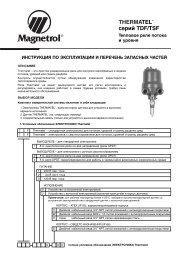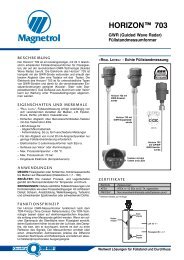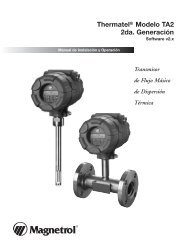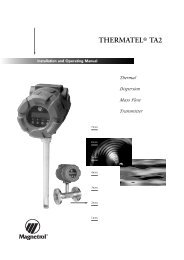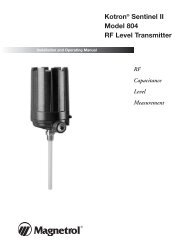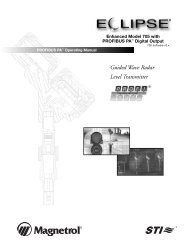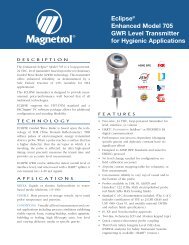Instruction Manual - Magnetrol International
Instruction Manual - Magnetrol International
Instruction Manual - Magnetrol International
You also want an ePaper? Increase the reach of your titles
YUMPU automatically turns print PDFs into web optimized ePapers that Google loves.
14<br />
ON DEMAND SELF-TEST (Integral or Remote Units)<br />
SELF-TEST<br />
With the transducer properly connected to the electronics,<br />
check to ensure all cable connections are correct.<br />
By pressing and holding the Wet Test Switch when the sensor<br />
is dry, a wet sensor condition will be simulated. This<br />
allows a manual self test of the system and a convenient<br />
method of verifying the time delay settings.<br />
The Malfunction Test Switch immediately forces a malfunction<br />
condition when it is pressed. This is true whether the sensor is<br />
wet or dry. When the switch is released, the true condition will<br />
be indicated (if any dry to wet delay has been set, there will be<br />
a delay before a wet sensor will be indicated).<br />
Setting the High/Low Malfunction current jumper (P2) on the<br />
amplifier board of two-wire units to the LOW position will<br />
cause a malfunction to force a loop current of 5 mA and<br />
extinguish both LEDs if a malfunction is detected. If this<br />
jumper is set to the HIGH position, both LEDs will illuminate<br />
and the loop current will be forced to 19 mA if a malfunction<br />
occurs.<br />
NOTE: If this board is part of a relay output model 91S, this<br />
jumper must be placed in the L position for proper operation.<br />
REMOTE MANUAL SELF-TESTING<br />
Self testing is accomplished automatically and continuously<br />
on the 91S/92S. Additionally, a manual self test operation<br />
can be performed on the amplifier board with S1 (malfunction)<br />
or S2 (wet) or can be wired into the terminal block of<br />
the power supply board (TB3) for 91S, or (TB4 & TB5) for<br />
92S. An external push button switch may be connected to<br />
TB3 on the single point power supply board (refer to Figure<br />
4) using a twisted pair to actuate a remote wet test or a malfunction<br />
test. The power source for this push button test is<br />
internal to the 91S/92S.<br />
NOTE: Remote manual self-testing is available on all fourwire<br />
models. It is not offered on the two-wire models.<br />
OPTO-ISOLATED OUTPUT<br />
An opto-isolator consists of a Light Emitting Diode (LED)<br />
and a phototransistor (refer to Figure 14). The phototransistor<br />
contains a light sensitive base that allows the transistor<br />
to conduct current only when it is exposed to light. The phototransistor<br />
provides a clean digital pulse, and since it is not<br />
directly connected (wired) to the LED, complete electrical<br />
isolation is achieved between the input and the output of<br />
the opto-isolator.<br />
The opto-isolator is encased in a plastic/epoxy case, to prevent<br />
“stray” light from affecting the output. The output is<br />
floating, meaning that it can be referenced to anything (preventing<br />
ground potential differences). It is polarity sensitive<br />
and has limits on voltage and current like any other electronic<br />
component.<br />
LED<br />
Field<br />
Instrument<br />
I.C. Package<br />
Light<br />
Figure 14<br />
Phototransistor<br />
Digital<br />
Controller<br />
OPTO-ISOLATED OUTPUT cont.<br />
The opto-isolator will not eliminate the need for relay outputs.<br />
The relay is still the best electrical method for switching<br />
high current loads. The opto-isolator however, is a better<br />
solution for use with digital controllers.<br />
The following illustrations depict methods for connecting the<br />
opto-isolator to a digital controller.<br />
Figure 15 shows a configuration that allows for a “currentshift”<br />
output. The states are: 8 mA when the phototransistor<br />
is “open” and 16 mA when the phototransistor is closed.<br />
Figure 15<br />
750 Ohms<br />
12Vdc<br />
750 Ohms<br />
Figure 16 shows a configuration that allows for a “voltageshift”<br />
output. The states are: 0 Vdc when the phototransistor<br />
is “open” and 5 Vdc when the phototransistor is closed. The<br />
output is taken across the 2.7K Ohm resistor.<br />
2.7K Ohms<br />
Figure 16<br />
5Vdc




